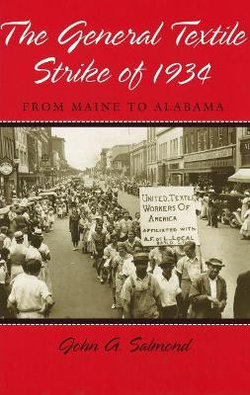

From Maine to Alabama
Hardback
Publication Date: 01/06/2002
In January 1933, the United Textile Workers of America was in danger of collapse. Its membership was no larger than 15,000; its attempts to organize southern workers had failed disastrously; and it was constantly under attack from rival organizations. Yet, barely eighteen months later, with 300,000 dues-paying members, with newly established or revived branches covering southern cotton textile workers, as well as northern woolen and worsted workers, silk and jacquard weavers, dyers and finishers, even rayon workers, and with locals in 208 cities, towns, and mill villages, UTW was about to embark on what one historian has termed ""the greatest single industrial conflict in the history of American labor."" The General Textile Strike of 1934 is the story of that conflict. The few historians who have concerned themselves at all with the 1934 textile strike have all concentrated on its southern aspect, presenting it as a southern event, a cotton textile event. No one argues that the South and cotton were not crucial to the strike's story. It was cotton mill workers' anger over broken promises of the National Industrial Recovery Act that had forced a reluctant UTW leadership into supporting a strike vote. No industry leader was more devious in his dealings with the UTW leaders than George Sloan, the chair of the Cotton Code Authority and head of the Cotton Textile Institute. Nevertheless, the 1934 strike was a nationwide one, involving hundreds of thousands of silk, woolen, and rayon workers, all represented by the UTW and mostly living in states outside the South. Moreover, Peter Van Horn and Arthur Besse, head of the Silk and Woolen Code Authorities, respectively, lost little to Sloan in their intransigence toward labor's demands. And, though the great transfer of the cotton industry from New England to the South was almost complete, there were still little pockets left in Massachusetts, Rhode Island, and Maine. In The General Textile Strike of 1934, John Salmond tells everyone's story. Looking at the strike from a national and an industrywide perspective, Salmond explains why workers were willing to risk protesting and describes the differences and similarities between southern and northern workers. Setting the strike within a New Deal context and focusing on its impact on the future of labor relations in the industry and the lives of those who participated in it, The General Textile Strike of 1934 fills an important gap in American labor history.
- ISBN:
- 9780826213952
- 9780826213952
- Category:
- Strikes
- Format:
- Hardback
- Publication Date:
- 01-06-2002
- Language:
- English
- Publisher:
- University of Missouri Press
- Country of origin:
- United States
- Pages:
- 320
- Dimensions (mm):
- 235x156x30mm
- Weight:
- 0.65kg
Click 'Notify Me' to get an email alert when this item becomes available
Great!
Click on Save to My Library / Lists
Click on Save to My Library / Lists
Select the List you'd like to categorise as, or add your own
Here you can mark if you have read this book, reading it or want to read
Awesome! You added your first item into your Library
Great! The fun begins.
Click on My Library / My Lists and I will take you there
Click on My Library / My Lists and I will take you there
Reviews
Be the first to review The General Textile Strike of 1934.


Share This Book: